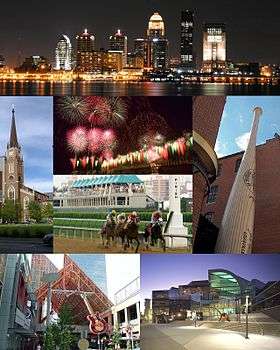Hillerich & Bradsby

Hillerich & Bradsby Company (H&B) is a company located in Louisville, Kentucky that produces the famous Louisville Slugger baseball bat. The Louisville Slugger Museum & Factory in downtown Louisville features a retrospective of the product and its use throughout baseball history. H&B also makes baseball gloves, golf clubs, golf gloves and other equipment (under the PowerBilt brand).
The company announced plans on March 23, 2015 to sell its Louisville Slugger division to sporting goods manufacturer Wilson Sporting Goods.[1]
History

J. F. Hillerich opened his woodworking shop in Louisville in 1855. During the 1880s, Hillerich hired his seventeen-year-old son, John "Bud" Hillerich. Legend has it that Bud, who played baseball himself, slipped away from work one afternoon in 1884 to watch Louisville's major league team, the Louisville Eclipse. The team's star, Pete "The Gladiator" Browning, mired in a hitting slump, broke his bat.
Bud invited Browning to his father's shop to hand-craft him a new bat to his own specifications. Browning accepted the offer, and got three hits to immediately break out of his slump with his new bat the first day he used it. Browning told his teammates, which began a surge of professional ball players to the Hillerich woodworking shop.
J. F. Hillerich was uninterested in making bats; he saw the company future in stair railings, porch columns and swinging butter churns. In fact, for a brief time in the 1880s, he even turned away ball players. Bud, however, saw the potential in producing baseball bats, and the elder Hillerich eventually relented to his son.
The bats were sold under the name "Falls City Slugger" until Bud Hillerich took over his father's company in 1894, and the name "Louisville Slugger" was registered with the U.S. Patent Office. In 1905, Honus Wagner signed a deal with the company, becoming the first baseball player to officially endorse a bat.[2]
Frank Bradsby, a salesman, became a partner in 1916, and the company's name changed to Hillerich and Bradsby. By 1923, H&B was selling more bats than any other bat maker in the country, and legends like Ty Cobb, Babe Ruth and Lou Gehrig were all using them.
During World War II, the company produced wooden rifle stocks and billy clubs for the U.S. Army.[3] In 1954, the company purchased Larimer and Norton, Inc., a Pennsylvania lumber company to ensure a supply of hardwood for their products.
In 1976, the company moved across the Ohio River, to Jeffersonville, Indiana, to take advantage of the railroad line there. In the 1990s, the company returned to Louisville, Kentucky.
Threat to business
Most of Hillerich and Bradsby's wood bats are made from Northern white ash grown in proprietary forests on the New York/ Pennsylvania border. Ash trees in the United States are now under attack from the emerald ash borer, an invasive insect species native to Asia and first detected in Michigan in 2002. While H&B's forests are not yet infested by the beetle, the area being destroyed is growing and moving closer to them. The company is making plans to utilize other woods in the event North America's ash forests are totally destroyed.
P72 baseball bat
The P72 model bat was created in 1954 for professional baseball player Leslie Wayne Pinkham. It became one of baseball's most popular bats. Baseball Hall of Famers Cal Ripken Jr. and Robin Yount are among the players who used the P72 over the years. New York Yankee Derek Jeter used the P72 for every at bat in his 20 MLB seasons, with over 12,500 plate appearances. On September 25, 2014, in honor of Jeter's impending retirement, the P72 designation was retired, and the bat was renamed the DJ2.[4] However descendants of Les Pinkam, for whom the P72 was created, will still be allowed to get the bat with its P72 designation.
In addition to retiring the P72 model number, Louisville Slugger also promised to give the final 72 P72 bats produced to Jeter to raise funds for his Turn 2 Foundation.
Branches of the company
There are three branches of Hillerich & Bradsby: Louisville Slugger, Bionic Gloves, and Powerbilt Golf. Bionic Gloves were designed by a leading orthopedic surgeon, and are used in many sports and recreational activities. Currently, there are 11 types of gloves: Golf, Gardening, Tennis, Fitness, Equestrian, Driving, Dress, Motorcycle, Racquetball, Baseball, and Drummer gloves. Powerbilt Golf produces many types of golf clubs. They recently introduced clubs that feature nitrogen charged technology.
Sponsorship
Besides its products, H&B attaches the Louisville Slugger name to other entities as a sponsor. The Cincinnati Reds' Triple A affiliate, the Louisville Bats, play at Louisville Slugger Field in downtown Louisville. The Louisville Slugger name is also attached to awards for top power-hitters at both the high school and college levels, and the Silver Slugger Award given annually to the Major League Baseball player with the best offensive output in each position. The Louisville Slugger Batting Champion award is given to the American Legion "player with the highest batting average during national competition."
MLB players that use Louisville Slugger
Current Players: Brandon Phillips, Josh Hamilton, Dustin Pedroia, Brandon Belt, Jay Bruce, Nelson Cruz, Michael Cuddyer, Andre Ethier, Alex Gordon, Curtis Granderson, Jason Heyward, Adam Jones, Ian Kinsler, Evan Longoria, Buster Posey, Hanley Ramírez, Ben Revere, Alex Ríos, Carlos Santana, Drew Stubbs, Melvin Upton, Jr., Justin Upton, Joey Votto, David Wright, Ryan Zimmerman, Evan Gattis, Chris Davis, Jurickson Profar, Pedro Álvarez, David Freese, Starlin Castro, Billy Hamilton,
Former MLB players: Derek Jeter, Hank Aaron, Jeff Bagwell, Ernie Banks, Alex Rodriguez, Johnny Bench
References
- ↑ Schneider, Grace (March 23, 2015). "Iconic bat maker Louisville Slugger sold". The Courier-Journal. Retrieved March 24, 2015.
- ↑ Surowiecki, James (December 21, 2009). "The Tiger Woods scandal and celebrity endorsements". The New Yorker. Retrieved September 28, 2012.
- ↑ Bedingfield, Gary. "Baseball in World War II". Baseball in Wartime. Retrieved July 25, 2014.
- ↑ http://m.mlb.com/news/article/96195366/louisville-slugger174-retires-p72-bat-model-in-honor-of-derek-jeter/
- Hill, Bob (2000). Crack of the Bat: The Louisville Slugger Story. ISBN 1-58382-012-4.
